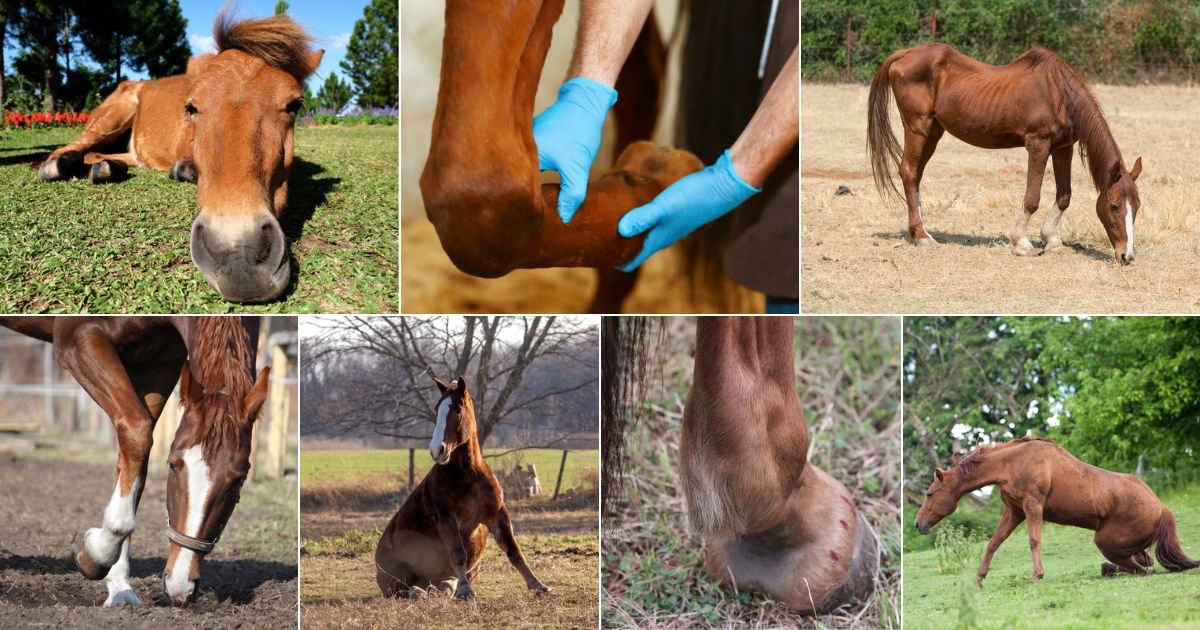What Is DSLD in Horses?
What Is DSLD in Horses?
What Is DSLD in Horses? DSLD stands for Degenerative Suspensory Ligament Desmitis, a progress and debilitating condition affecting horses of all breeds and ages. It is painful, chronic, and affects horse's suspensory ligaments, which are critical to their comfort and overall locomotion. This disorder is widely recognized as a significant health challenge in the equine community. This article will explore causes, symptoms, management strategies, and diagnosis, providing horse caretakers and owners with comprehensive insight into these conditions.

What is DSL?
Degenerative Suspensory Ligament Desmitis, or DSLD, is a degenerative and systemic condition primarily affecting the suspensory ligament of horses. These ligaments are essential to maintaining proper movement and supporting the fetlock joint. Over time, the ligament degenerates and weakens, leading to structural abnormalities, lameness, and chronic pain. Although this disease affects the suspensory ligament, it may be considered a systemic disorder as it may also impact other connective tissues, including internal organs and tendons.
The exact cause of DSLD is not fully understood, but systematic collagen abnormalities, genetic predispositions, and chronic inflammation are believed to contribute. Certain breeds, such as saddlebreds, warmbloods, and Peruvian Pasos, appear more susceptible. There is no cure for DSLD, and treatment focuses on slowing disease progression, managing pain, and improving the horse's quality horse's life.
Causes of DSLD
The exact causes of DSLD are not fully understood, but several factors have been identified:
Genetics: Certain horse breeds, such as saddlebreds and Warmbloods, are more predisposed to DSLD, suggesting a hereditary component. Research has shown that these breeds may carry mutations or genetic markers that predispose them to connective tissue disorder.
Systematic disorder: DSLD is believed to be a systematic disorder rather than a localized ligament issue. Studies suggest that the condition involves degradations or abnormal production of collagen, a protein that gives connective tissues their elasticity and strength. This systematic dysfunction can lead to weakened structures throughout the body.
Age and use: Horses subjected to repetitive stress due to high-performance activities or older horses may be more susceptible to developing DSLD. However, it also occurs in younger horses, indicating that other factors beyond wear and tear contribute to its onset.
Inflammation and cellular changes: Some studies suggest that DSLD may involve degenerative cellular changes within the connective tissue or chronic inflammation. These can lead to hardening, loss of elasticity in affected tissues, or abnormal thickening.

Symptoms of DSLD
The symptoms of DSLD can vary depending on the progression and severity of the condition. Early symptoms may be subtle and easily overlooked. But as the disease progresses, symptoms become more pronounced. Common signs include:
Persistent lameness: Horses with DSLD often exhibit persistent or intermittent lameness, especially after exercise. The lameness may not respond to standard treatment or rest.
Swelling and heat: swelling and heat in the suspensory ligament area are common, particularly in the hind limb. This may initially resemble a typical soft tissue injury.
Dropped fetlocks: The fetlock may drop closer to the ground as the suspensory ligament weakens, creating a characteristic sagging appearance.
Reluctance to move: affected horses may show reluctance to trot, walk, or canter, often displaying discomfort or pain, especially during transitions or uneven ground.
Systematic issues: some horses may exhibit additional signs such as stiffness, difficulty rising, or back pain.
Behavioral changes: Horses with DSLD may display changes in behavior, such as depression, irritability, and resistance to handling and work.
Diagnosis of DSLD
Diagnosing DSLD can be challenging, as its symptoms may mimic other musculoskeletal conditions. Veterinary evolution is essential. It includes the following:
Clinical examination: The first step is a detailed physical examination focusing on the fetlocks, suspensory ligaments, and overall posture. The veterinarian looks for swelling, signs of lameness, and dropped fetlocks.
Ultrasound imaging: a critical diagnostic tool for assessing the suspensory ligament's to ligament's ultrasound. It can reveal changes in ligament structure, such as fiber disruption, mineralization, or thickening.
Radiography (X-rays): X-rays may be used to evaluate the bony structures around the affected areas. In advanced cases, changes in the pastern bones or fetlock joints may be visible.
Genetic testing: genetic testing may identify affected individuals or carriers for breeds with known genetic predisposition to DSLD.
Biopsy: In some cases, a biopsy of the suspensory ligament may be performed to confirm the diagnosis. The historical examination can reveal characteristic degeneration in the ligament fibers.
Early diagnosis is crucial for managing DSLD effectively as it alleviates pain, slows progression, and improves the horse's quality.
Management and Treatment
There is no cure for DSLD currently as it is a degenerative and progressive condition. Treatments of DSLD focus on slowing disease progression, managing symptoms, and improving the horse's quality. Key management strategies include:
Pain management:
- Nonsteroidal anti-inflammatory drugs like firocoxib or phenylbutazone may help reduce inflammation and pain.
- Chiropractic care, acupuncture, and massage therapy can relieve some horses' pain.
Supportive care:
- Proper hoof care can help reduce strain on the suspensory ligament and improve the horse's posture. Supportive boots or wraps can help stabilize the fetlock and provide additional support.
Exercise modification:
- Avoiding uneven terrain and limiting strenuous activities could exacerbate the condition.
- Turnout or gentle hand-walking in a soft, flat area may help maintain muscle toe and circulation without overloading the ligament.
Nutritional support
- A balanced diet with supplements like glucosamine, omega-3 fatty acids, and chondroitin sulfate may support ligament and joint health.
- Antioxidants like selenium and vitamin E can help reduce inflammation and support overall cellular health.
Stem cell therapy has been explored as a potential treatment to regenerate damaged ligament tissue in some cases. However, its effectiveness for DSLD remains under investigation.
Euthanasia: Humane euthanasia may be the most compassionate option to prevent further suffering in advanced cases where the horse's mobile horse's pain is severely compromised.
Preventing DSLD in Horses
While DSLD cannot always be prevented due to its systematic and genetic nature, there are steps horse owners can take to reduce the risk or delay its onset.
Breeding practices: Avoid breeding with a familial predisposition or a known history of DSLD, particularly in susceptible breeds like Warmbloods, saddle breeds, and Peruvian Pasos. Responsible breeding can help minimize the spread of genetic factors linked to DSLD.
Early detection: Regular veterinary checkups are essential for identifying early signs of inflammation and/or ligament weakness. Early diagnosis allows for interventions that may slow progression.
Proper training and workload: Avoid overworking unconditioned or young horses and ensure their exercise regimen is appropriate for their fitness level, age, and confirmation. Repeated stress on ligaments should be minimized.
Balanced nutrition: Provide a diet rich in minerals, vitamins, and connective tissue-supporting nutrients such as glucosamine and omega-3. Maintaining optimal weight also reduces strain on the limb.
Prevention care: Proper shoeing and regular hoof care by a skilled farrier can reduce strain on the suspensory ligament. Even soft turnout surfaces further minimize injury risks.
While prevention is not guaranteed, proactive care can support overall well-being and ligament health.
Living with a Horse Diagnosed with DSLD
Caring for a horse diagnosed with Degenerative Suspensory Ligament Desmitis requires compassion, dedication, and patience. While the conditions are incurable and progressive, proper care and management can improve the horse's quality and comfort. Pain management, supportive care, and nutritional support can help alleviate discomfort and may provide additional relief.
Open communication with your farrier, veterinarian, and other equine professionals is essential for managing the conditions effectively. While DSLD can be heartbreaking, many horses can enjoy a comfortable life in early-stage disease with proper management and care.
Conclusion
Degenerative Suspensory Ligament Desmitis, or DSLD, is a complex and challenging condition that profoundly impacts horses and their owners. Understanding its symptoms, causes, and management strategies is crucial for providing the best possible care to affected horses. Horse owners can help their equine partners navigate this condition with compassion and dignity by staying informed and working closely with veterinary professionals.


















